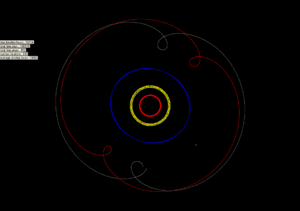Plutino facts for kids
A plutino is a special kind of space object that orbits the Sun in a way very similar to how Pluto orbits. These objects are usually found quite far out, about 39 or 40 AU from the Sun. An AU, or Astronomical Unit, is the average distance from the Earth to the Sun, which is about 150 million kilometers (93 million miles). So, plutinos are much, much farther away than Earth!
Contents
What Makes a Plutino Special?
Plutinos are unique because of how their orbits are connected to Neptune, one of the giant planets in our Solar System. They have something called an "orbital resonance" with Neptune. This means that for every two times a plutino goes around the Sun, Neptune goes around exactly three times. This is known as a 2:3 resonance.
Why the 2:3 Resonance Matters
This special 2:3 resonance helps to keep plutinos safe from Neptune's strong gravity. Without this resonance, Neptune's pull could easily change their orbits, making them unstable or even throwing them out of the Solar System. The resonance acts like a gravitational dance, keeping the plutinos in a stable path over billions of years. It's like they have a protected lane in space!
Where Do Plutinos Live?
Most plutinos are found in a region of our Solar System called the Kuiper Belt. The Kuiper Belt is a huge ring of icy objects beyond Neptune's orbit. It's like a cosmic junkyard filled with countless small bodies, including dwarf planets like Pluto itself. Plutinos are some of the most common types of objects in the inner part of the Kuiper Belt.
Famous Plutinos
The most famous plutino is, of course, Pluto! Even though Pluto is now classified as a dwarf planet, it was the first object discovered with this special 2:3 orbital resonance with Neptune. That's why these objects are named "plutinos," meaning "little Plutos." Another well-known plutino is 90482 Orcus, which is quite large and sometimes called the "anti-Pluto" because its orbit is opposite to Pluto's in some ways.
How Plutinos Help Scientists
Studying plutinos helps scientists understand how our Solar System formed and evolved. Their stable orbits tell us a lot about the early movements of the giant planets, especially Neptune. By observing these distant objects, astronomers can learn more about the conditions in the outer Solar System billions of years ago. They are like time capsules, holding clues about our cosmic past.
Images for kids
See also
 In Spanish: Plutino para niños
In Spanish: Plutino para niños



